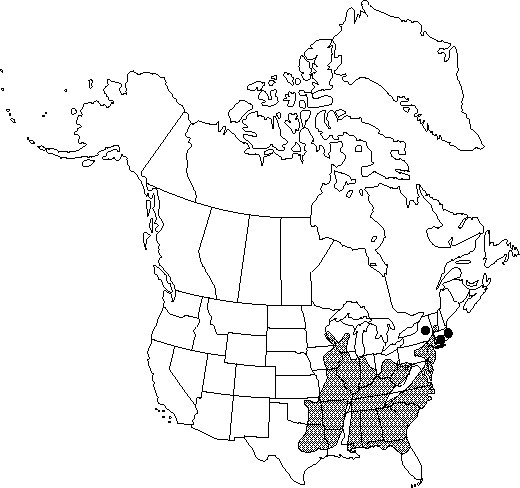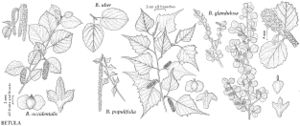Difference between revisions of "Betula nigra"
Sp. Pl. 2: 982. 1753.
FNA>Volume Importer |
FNA>Volume Importer |
||
| Line 30: | Line 30: | ||
}}<!-- | }}<!-- | ||
| − | --><span class="statement" id="st- | + | --><span class="statement" id="st-undefined" data-properties=""><b>Trees,</b> to 25 m; trunks often several, crowns round. <b>Bark</b> of mature trunks and branches grayish brown, yellowish, reddish, or creamy white, smooth, irregularly shredding and exfoliating in shaggy sheets when mature; lenticels dark, horizontally expanded. <b>Twigs</b> without wintergreen taste or odor, glabrous to sparsely pubescent, often with scattered, tiny, resinous glands. <b>Leaf</b> blade rhombic-ovate, with 5–12 pairs of lateral veins, 4–8 × 3–6 cm, base broadly cuneate to truncate, margins coarsely doubly serrate to dentate, apex acuminate; surfaces abaxially moderately pubescent to velutinous, especially along major veins and in vein axils, often with scattered, minute, resinous glands. <b>Infructescences</b> erect, conic or nearly globose, 1.5–3 × 1–2.5 cm, shattering with fruits in late spring or early summer; scales often persistent into early winter, lobes 3, ascending, branching distal to middle, narrow, elongate, equal to somewhat unequal in length, apex acute. <b>Samaras</b> with wings narrower than body, usually broadest near summit, not extended beyond body apically. <b>2n</b> = 28.</span><!-- |
-->{{Treatment/Body | -->{{Treatment/Body | ||
| Line 62: | Line 62: | ||
|publication year=1753 | |publication year=1753 | ||
|special status=Endemic;Selected by author to be illustrated;Weedy | |special status=Endemic;Selected by author to be illustrated;Weedy | ||
| − | |source xml=https://jpend@bitbucket.org/aafc-mbb/fna- | + | |source xml=https://jpend@bitbucket.org/aafc-mbb/fna-data-curation.git/src/9216fc802291cd3df363fd52122300479582ede7/coarse_grained_fna_xml/V3/V3_865.xml |
|subfamily=Betulaceae subfam. Betuloideae | |subfamily=Betulaceae subfam. Betuloideae | ||
|genus=Betula | |genus=Betula | ||
|species=Betula nigra | |species=Betula nigra | ||
| − | |||
| − | |||
| − | |||
| − | |||
| − | |||
| − | |||
| − | |||
| − | |||
| − | |||
| − | |||
| − | |||
| − | |||
| − | |||
| − | |||
| − | |||
| − | |||
| − | |||
| − | |||
| − | |||
| − | |||
| − | |||
| − | |||
| − | |||
| − | |||
| − | |||
| − | |||
| − | |||
| − | |||
| − | |||
| − | |||
| − | |||
| − | |||
| − | |||
| − | |||
| − | |||
| − | |||
| − | |||
| − | |||
| − | |||
| − | |||
| − | |||
| − | |||
}}<!-- | }}<!-- | ||
-->[[Category:Treatment]][[Category:Betula]] | -->[[Category:Treatment]][[Category:Betula]] | ||
Revision as of 13:52, 27 July 2019
Trees, to 25 m; trunks often several, crowns round. Bark of mature trunks and branches grayish brown, yellowish, reddish, or creamy white, smooth, irregularly shredding and exfoliating in shaggy sheets when mature; lenticels dark, horizontally expanded. Twigs without wintergreen taste or odor, glabrous to sparsely pubescent, often with scattered, tiny, resinous glands. Leaf blade rhombic-ovate, with 5–12 pairs of lateral veins, 4–8 × 3–6 cm, base broadly cuneate to truncate, margins coarsely doubly serrate to dentate, apex acuminate; surfaces abaxially moderately pubescent to velutinous, especially along major veins and in vein axils, often with scattered, minute, resinous glands. Infructescences erect, conic or nearly globose, 1.5–3 × 1–2.5 cm, shattering with fruits in late spring or early summer; scales often persistent into early winter, lobes 3, ascending, branching distal to middle, narrow, elongate, equal to somewhat unequal in length, apex acute. Samaras with wings narrower than body, usually broadest near summit, not extended beyond body apically. 2n = 28.
Phenology: Flowering late spring.
Habitat: Riverbanks and flood plains, often where land is periodically inundated
Elevation: 0–300 m
Distribution

Ala., Ark., Conn., Del., D.C., Fla., Ga., Ill., Ind., Iowa, Kans., Ky., La., Md., Mass., Minn., Miss., Mo., N.J., N.Y., N.C., Ohio, Okla., Pa., S.C., Tenn., Tex., Vt., Va., W.Va., Wis.
Discussion
Betula nigra is a large and characteristic floodplain tree. Like several other species of this habitat (e.g., Acer saccharinum Marshall and Ulmus americana Linnaeus), it releases its fruits in early summer; the seeds germinate immediately (at a time when the surrounding land is unlikely to be flooded). The wood of Betula nigra is not in high demand for timber because of its generally poor quality. Cultivars with freely exfoliating bark are commonly cultivated in the Northeast and Midwest.
Native Americans used Betula nigra medicinally to treat dysentery, colds, and milky urine (D. E. Moerman 1986).
Selected References
None.
